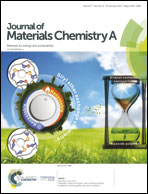From rational design of a new bimetallic MOF family with tunable linkers to OER catalysts†
Abstract
Innovative bimetallic MOFs offer more possibilities to further tailor the properties of MOFs, which have attracted great attention for wide applications. However, it is still a great challenge to rationally design bimetallic MOFs due to the lack of a tunable and reasonable hybrid structure architecture. Herein, a new series of bimetallic metal–organic frameworks (MOFs) with tunable pillar linkers were prepared by a one-step synthesis method. These bimetallic MOFs retain the same crystal structure when the mole fraction (based on metal) of the two metals changes from 0 to 1 and both metal ions occupy random nodal positions. The incorporation of a second metal cation has a large influence on the intrinsic properties (e.g. thermal stabilities and band gaps) of the MOFs. Furthermore, these bimetallic MOFs were used as self-sacrificial templates to prepare bimetal oxide catalysts for the oxygen evolution reaction (OER). After pyrolysis, a porous and hierarchical honeycomb-like structure with carbon network covered (bi)metal oxides is formed. Among all the bimetallic MOF-derived catalysts, CoNi1@C showed the best performance for the OER with the lowest Tafel slopes (55.6 mV dec−1) and overpotentials (335 mV on a glassy carbon electrode and 276 mV on Ni foam) at a current density of 10 mA cm−2, which is higher than those of state-of-the-art Co–Ni mixed oxide catalysts derived from MOFs for the OER. Our results indicate that the incorporation of a second metal ion is a promising strategy to tailor the properties of MOFs. More importantly, this new bimetallic MOF family with tunable linkers is expected to serve as a flexible assembly platform to offer broad possibilities for practical applications of MOFs.



 Please wait while we load your content...
Please wait while we load your content...